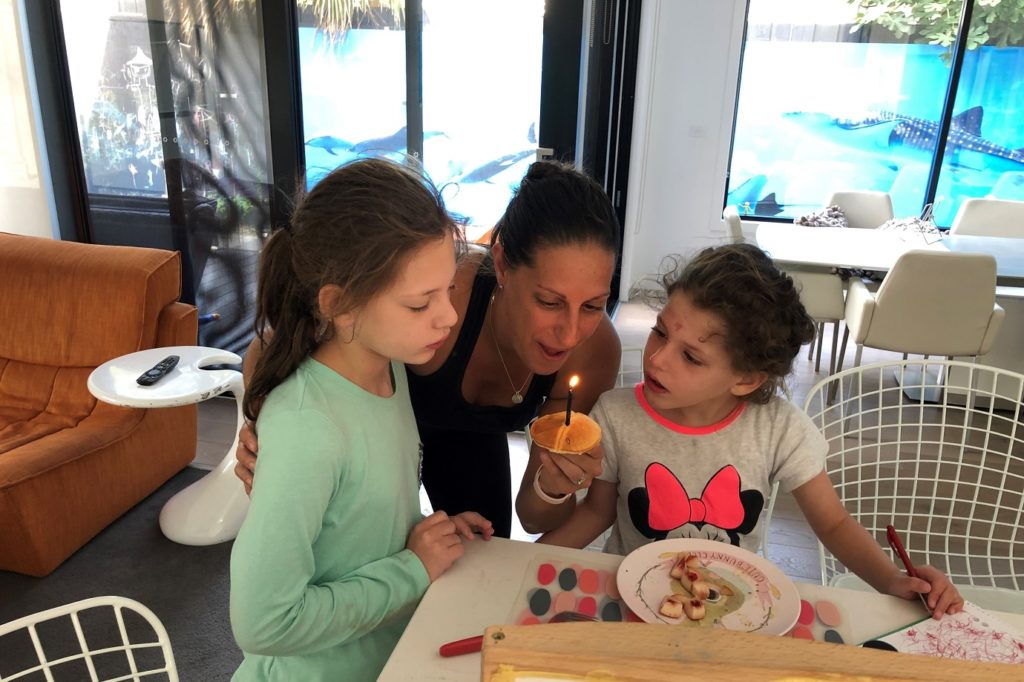For years I’ve walked a tightrope with my professional life on one side and personal life on the other. Two very separate existences. Slowly, as I’ve become more comfortable sharing my personal story the tightrope has become steadier. I have become more comfortable with the rope and learnt to stop looking down.
Today, after years of balancing (well at least attempting to), the tightrope has disintegrated, and I’m still standing, now ready to share my story.
I have been dancing on the personal-work-life tightrope since 2012. The journey began eight years ago when my second daughter was three months old and I started consulting to AIA Australia to help launch Vitality into the Australian market.
Over the next three years, I juggled the darkest times of my personal life while effectively working in a start-up. I was in survival mode, emotionally for myself and literally for my children… and I rarely mentioned a word of it to my colleagues.
My husband and I were dealing with our 2.5 year-old, Jaeli, who had developed uncontrolled seizures (in fact hundreds a day), extreme behaviours, autistic features, childhood insomnia, three-hour nightly and daily screaming fits, self-injurious behaviour and cognitive delays.
My second daughter, Dali, born 2 years after Jaeli, had hit all of her milestones at the age of one, before we saw it – that first sign – the subtle eye lid seizures. This time we knew how those subtle eyelid seizures would progress.
We were heartbroken.
In those early years, we were driven by the sense of urgency to get a diagnosis and ‘fix’ our kids, acutely aware of the neurodevelopmental plasticity window closing further every day.
My survival technique was to compartmentalise.
I was in survival mode at home and work was my escape. An escape from the helplessness I felt watching our beautiful girls suffer, every attempt to help them only making them worse.
I didn’t intentionally hide the situation from my colleagues, but I rarely mentioned it. I didn’t want to burden others with my pain, I didn’t want them to pity me and I definitely didn’t want to be treated differently.
Unknowingly, I was protecting my illusion of control.
Our journey took a new direction and energy when we finally received a diagnosis for the girls in 2016. At that time they were four and six years old. We were one of the first in Australia to undergo whole genome sequencing, and after five long years we had a name for our enemy. It was a rare genetic epilepsy called Syngap. At the time, there were less than 100 diagnosed in the world, now, four years later, there are almost 600.

Knowledge is power and armed with a diagnosis, we became empowered to change our daughters’ destinies. We were buoyed learning that there has never been a better time for science, medical discoveries, precision medicine and gene therapy.
We connected with other families, with researchers and clinicians who gave us hope that precision medicine was a realistic concept for our kids.
Next, we established Syngap Research Fund Australia, co-founded Genetic Epilepsy Team Australia (GETA) and the Syngap Global Network. We advocated for whole genome sequencing, jumped into collating data on the condition which inspired the largest Syngap study, published in the neurology journal in 2019 on which I was a co-author. We lobbied government, leading to a $2m investment in genetic epilepsy research, which kickstarted our Syngap research project in 2018 at the Florey Institute for Neuroscience and Mental Health.
We’ve learnt along the way that those who bear the burden of disease have an unrelenting passion like no other which accelerates scientific breakthroughs.
And, I’ve slowly learnt, that the two worlds – professional and personal – that I had deliberately kept apart, could in fact benefit one another. I learnt the tightrope could in fact become a runway.
Professionally, I thrive in a team environment, partly because I own my shortcomings and naturally seek partnerships that combine complementary skillsets and genuinely subscribe to the shared value concept. I like to rely on others and I like to be relied on.
Personally, I am inspired by those I fight shoulder to shoulder with in battle from our Genetic Epilepsy Team Australia group, to the Syngap Global Network team, and my husband who is so driven and optimistic, grateful for that optimism especially when I am not.
Only recently have I realised the same theory of combining complementary skills applies to the two versions of myself – the “professional” version and the “rare disease mum” version… that each contribute to the same person.
I’m surprised and grateful that the skills I’ve obtained in each of these versions of myself are transferrable. That my persistence, optimism, passion, empathy, tolerance and resilience straddle both sides of that tightrope, ultimately bringing strength and balance to both.
Through this journey, I’ve also learnt the power of gratitude. I am grateful for my family, friends, community and personal network that have loved me in my darkest times. And, I am indebted to AIA Australia, and particularly Damien Mu, who have supported me professionally, and who chose to keep my tightrope taut when I felt the need to keep my two roles as “employee” and “rare disease mum” balanced, but apart.
Today, after eight years trying to balance the tightrope, I feel empowered by that runway on which I can make a difference in both my professional and personal roles.
This is an edited version of a post that Danielle first published on LinkedIn. It’s shared here with permission.
For more information on Syngap Research Australia, click here. Or check them out on Facebook or Twitter.
You can find more information on GETA: Genetic Epilepsy Team Australia here, or on Facebook or Twitter


